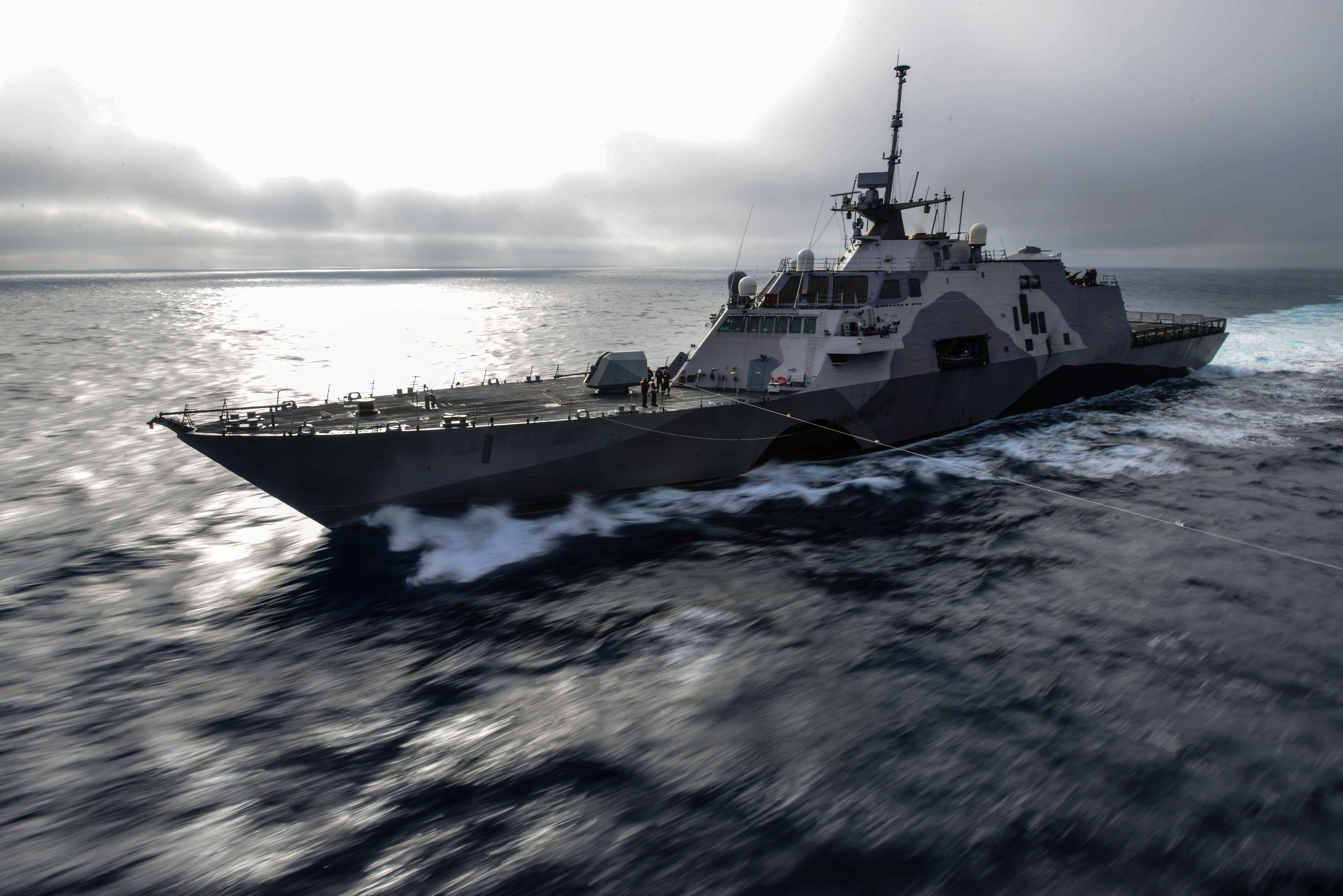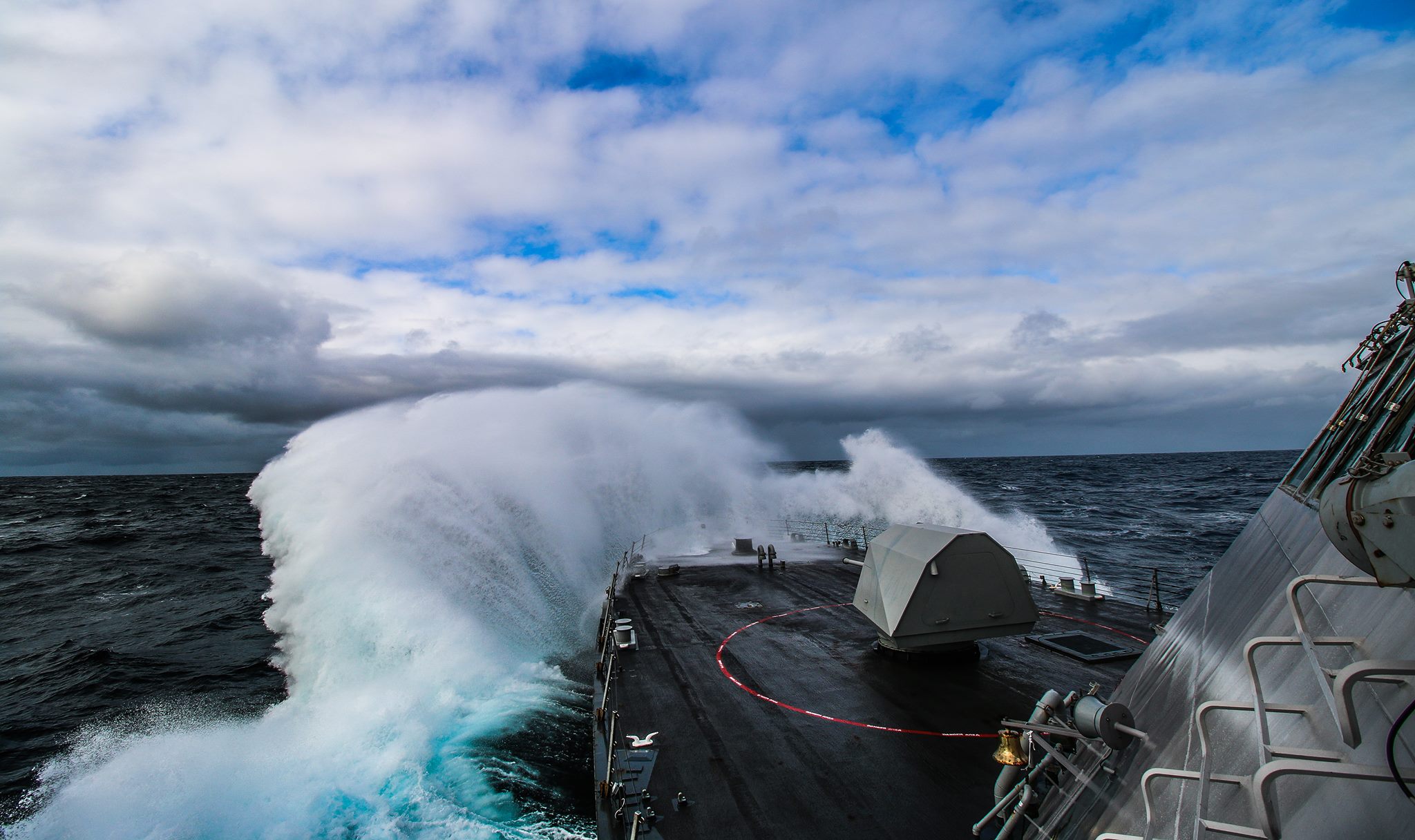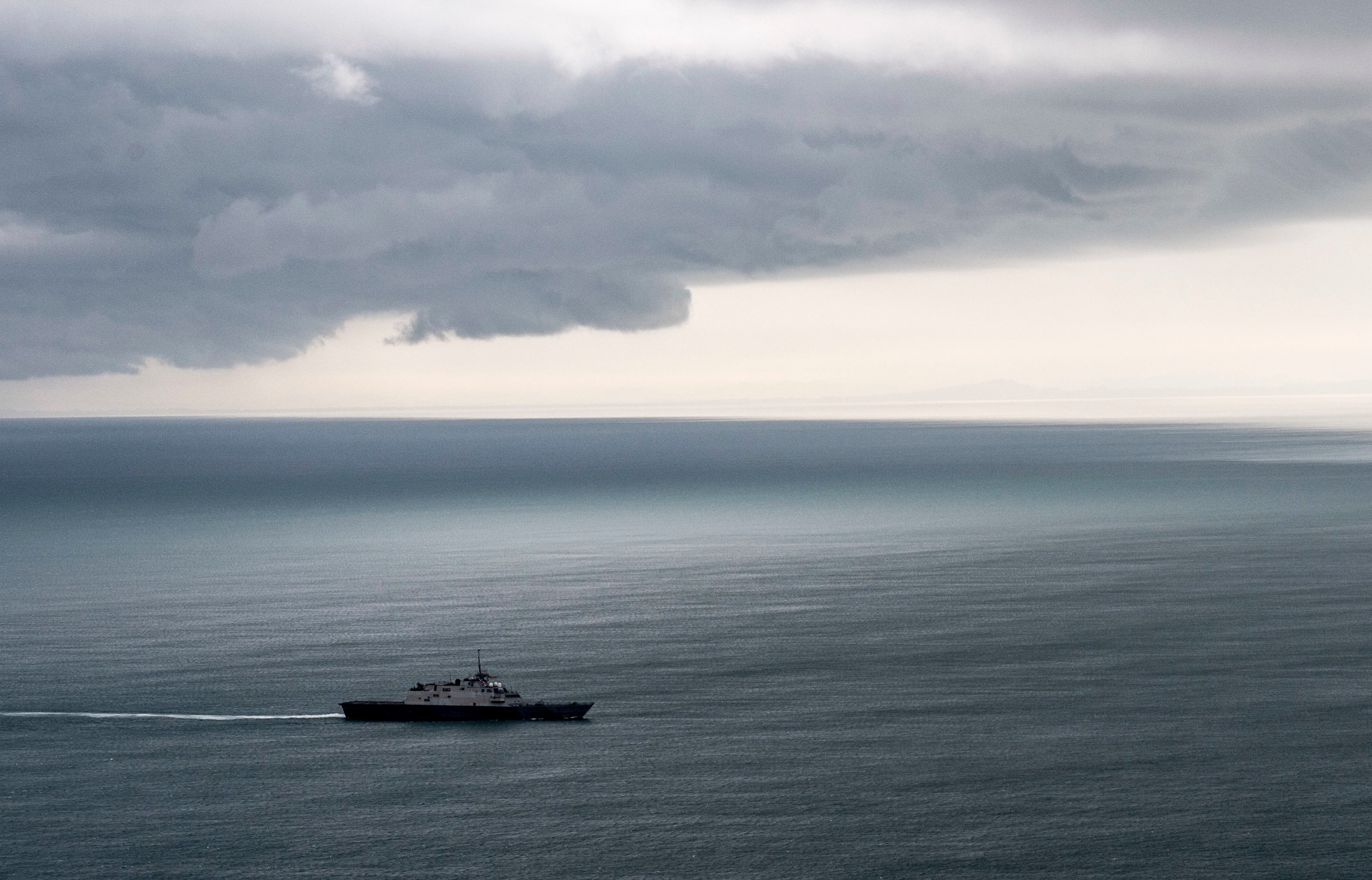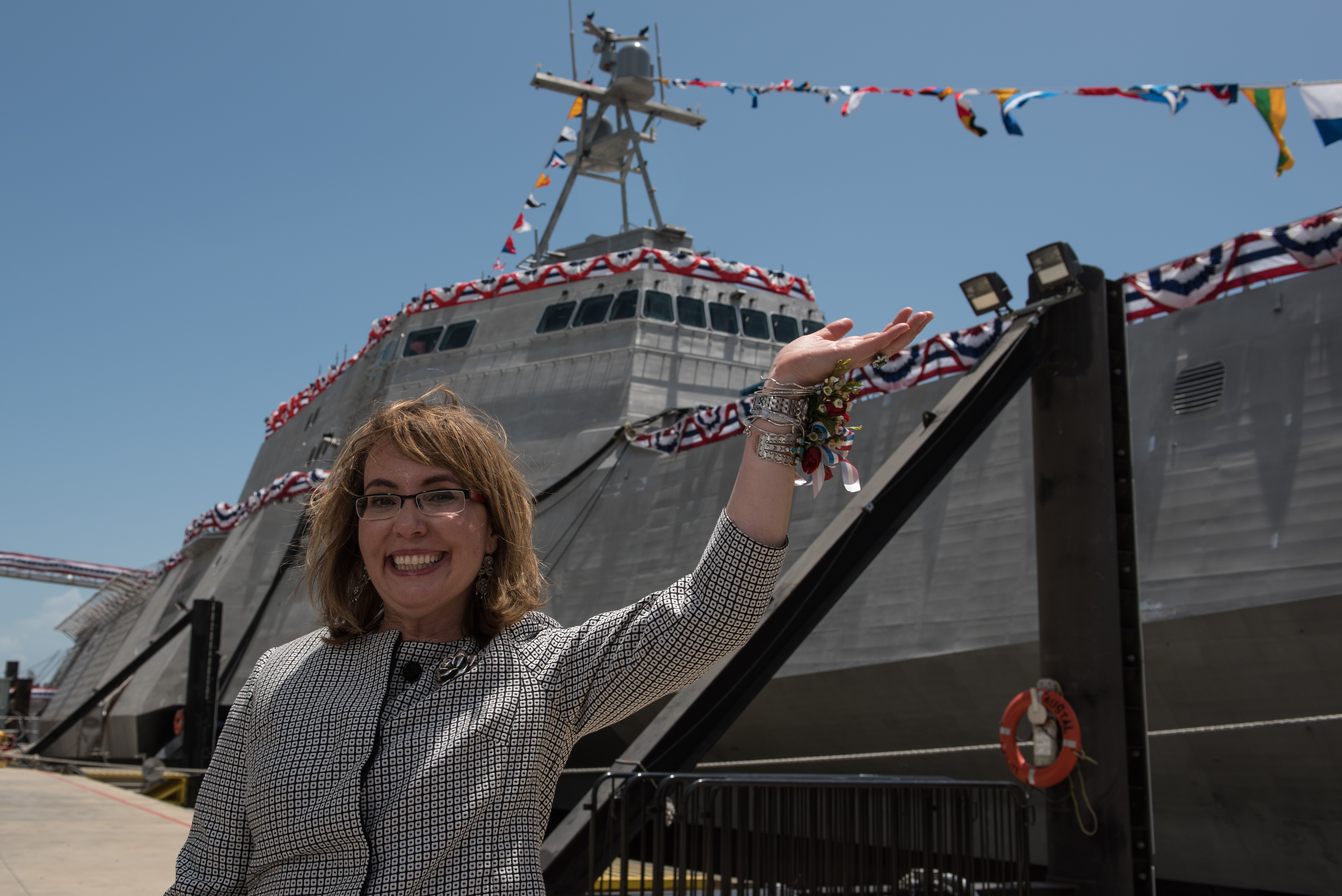
The Littoral Combat Ship program will reach several major milestones in the coming months, from conducting full ship shock trials on both hull variants, to demonstrating a new expeditionary mine mission package, to refining operational concepts, the outgoing program executive officer told USNI News in a May 2 interview.
Rear Adm. Brian Antonio said the program had made significant progress during his three years as PEO – he christened nine ships and commissioned three, among other achievements – but “it’s a bittersweet time to be leaving the program,” he said.
USS Jackson (LCS-6) will be the first ship since 2008 to undergo full ship shock trials, Antonio said. The Navy plans to fire its first shot in the first week of June, with the next two shots of increasing severity coming in two-week intervals. The ship would return to Mayport, Fla., in between the three shots for data collection and analysis. USS Milwaukee (LCS-5) will undergo the same test later in the summer, Antonio said, joking that the tests were planned in between whale migration season and hurricane season.
“This is no kidding, things moving, stuff falling off of bulkheads. Some things are going to break. We have models that predict how electronics are going to move and cabinets are going to move, but some things are going to happen, and we’re going to learn a lot from this test,” he said, noting the last time the Navy conducted a live shock trial was on the amphibious transport dock USS Mesa Verde (LPD-19) in 2008.
Also this summer, both USS Coronado (LCS-4) and USS Freedom (LCS-1) will participate in the Rim of the Pacific exercise in Hawaii. Coronado will demonstrate an over-the-horizon missile capability before heading out for the ship’s maiden deployment to Singapore.
Freedom will use RIMPAC to demonstrate a previously unplanned capability, which Antonio said was the Navy taking advantage of an opportunity that presented itself. Whereas PEO LCS has focused primarily on developing new mine countermeasures systems to keep sailors far from the minefield, the Naval Surface and Mine Warfighting Development Center (SMWDC) will deploy an “expeditionary mine warfare package” consisting of legacy MCM systems during the international exercise.
“They’re really excited about getting out there and playing with an LCS with the expeditionary mine package,” Antonio said of SMWDC, which stood up in June 2015.
“That’s something we hadn’t really planned for. … We said hey, here’s an opportunity to go take LCS-1 and use her during RIMPAC with the expeditionary” package.
The first Common Unmanned Surface Vehicle (CUSV), which will tow a minesweeper as part of the MCM mission package and may tow a sonar for mine hunting, will deliver and immediately begin testing in June, Antonio said. And surface-to-surface testing of the Longbow Hellfire missile, which will be added to the surface warfare mission package, is also scheduled for later this year.

Beyond the material side of the LCS program – the two distinct ship hulls and the components that make up three mission packages – a lot of questions remain about how the fleet will man, operate and maintain the LCS fleet, and those questions may be answered in the near future, Antonio said. Chief of Naval Operations Adm. John Richardson and acquisition chief Sean Stackley in March ordered an LCS Review Team to assess manning, training, maintenance and the mission package composition.
Vice Adm. Tom Rowden, commander of naval surface forces, had led this review effort and is getting ready to brief Richardson on the findings, Antonio said, which could either reaffirm Navy assumptions about how its LCS fleet would operate or force leadership to chart a new path forward.
On the manning side, Antonio said the Navy would have to decide if the current 3-2-1 construct – three crews supporting two ship hulls, one of which is always forward – is feasible going forward. There are enough sailors to support this now, Antonio said, but it is unclear if the Navy can continue this as the LCS fleet grows to an eventual 28 ships.
On maintenance, Antonio said the results of a “very successful pilot” program Congress authorized may alter how Singapore-based maintenance is handled. In the pilot program, “we’re finding that the cost-avoidance is well over 50 percent what the cost would have been if we had flown lower-skilled workers all the way to Singapore, halfway – literally halfway around the world, paid them per diem, paid them to stay in hotels in Singapore, as opposed to just using the local workforce in a limited case.” Antonio said the Navy is statutorily obligated to use American workers in most cases, but this pilot program could lead to some expanded authority to use local workers in some instances to save money.
And on mission packages, Antonio said the outcome of the review may affect ship and mission package laydown around the globe, the size and number of mission package support facilities, and more. Though he said he does not know where Rowden will come down on this issue, from his own experience Antonio believes the Navy may not swap mission packages as much as originally thought.
“Certain LCSs just kind of get to be known as, LCS-pick-a-number is a mine package, and unless a major world event happens it will predominantly for its whole life be a mine package ship,” he said as an example. Though today only the surface warfare package has reached initial operational capability (IOC) and can deploy, Antonio said he didn’t think the Navy would get into the habit of spending time and money in port to swap mission packages just because it can.

Beyond these short-term fleet demonstrations and decisions on the LCS’s path forward, Antonio said some challenges loom farther out. When the Navy selects a single shipbuilder to continue on to the frigate program, the losing shipyard may not have enough work to stay in business, Antonio said, which will force the Navy to pay close attention to make sure that yard’s final LCSs meet price and quality standards.
“There is some risk that as the selection occurs, at the losing yard that those ships then would increase in cost. Of course the government cost is limited – these are fixed price contracts – so we would expect that perhaps those ships could go as high as ceiling, and the overhead would obviously be condensed,” he said.
“A lot of it is incumbent on the shipbuilder themselves. The shipbuilders will, I believe, have a decision to make as far as whoever the losing shipbuilder would be, do they continue to, say, pursue other opportunities like in the private sector for commercial type work instead of just looking to Navy work? And if that’s the case then I’m sure that they don’t want to have their performance be so poor that then they can’t compete very well for any kind of commercial work.”
Antonio said the losing yard would still have about three years of LCS work remaining after the frigate decision is announced.

Though the last three years have brought some major changes to the program – including both the creation of the frigate follow-on design and then the curtailing of the frigate program and the need to downselect to a single vendor – Antonio said it has been a great three years as PEO.
“We’ve essentially doubled the size of the LCS fleet under my watch,” he said, going from three to six commissioned ships. Antonio christened nine ships in three years, oversaw the IOC declaration for both ship hulls and the surface warfare mission package, and continued buying the ships at a pace that puts the LCS program on track to become the second largest ship class in the Navy. Operationally, the Navy stood up an East Coast-based LCS squadron (LCSRON) to support ships in Mayport, opened a remote operating site in Pensacola and tested an expeditionary maintenance concept out of Japan to extend the legs of the ship.
Antonio’s next assignment has not yet been formally announced, but he will turn the LCS program over to Rear Adm. John Neagley next week. Neagley, who most recently served as deputy commander for fleet readiness at the Space and Naval Warfare Systems Command (SPAWAR), was the lead requirements officer for LCS in 2003 and has worked with the program during several assignments since then.
“Adm. Neagley is going to be a perfect replacement for me, he’s an LCS alum,” Antonio said.
“He’s going to be great: he understands Washington, he understands NAVSEA, has fleet experience.”





